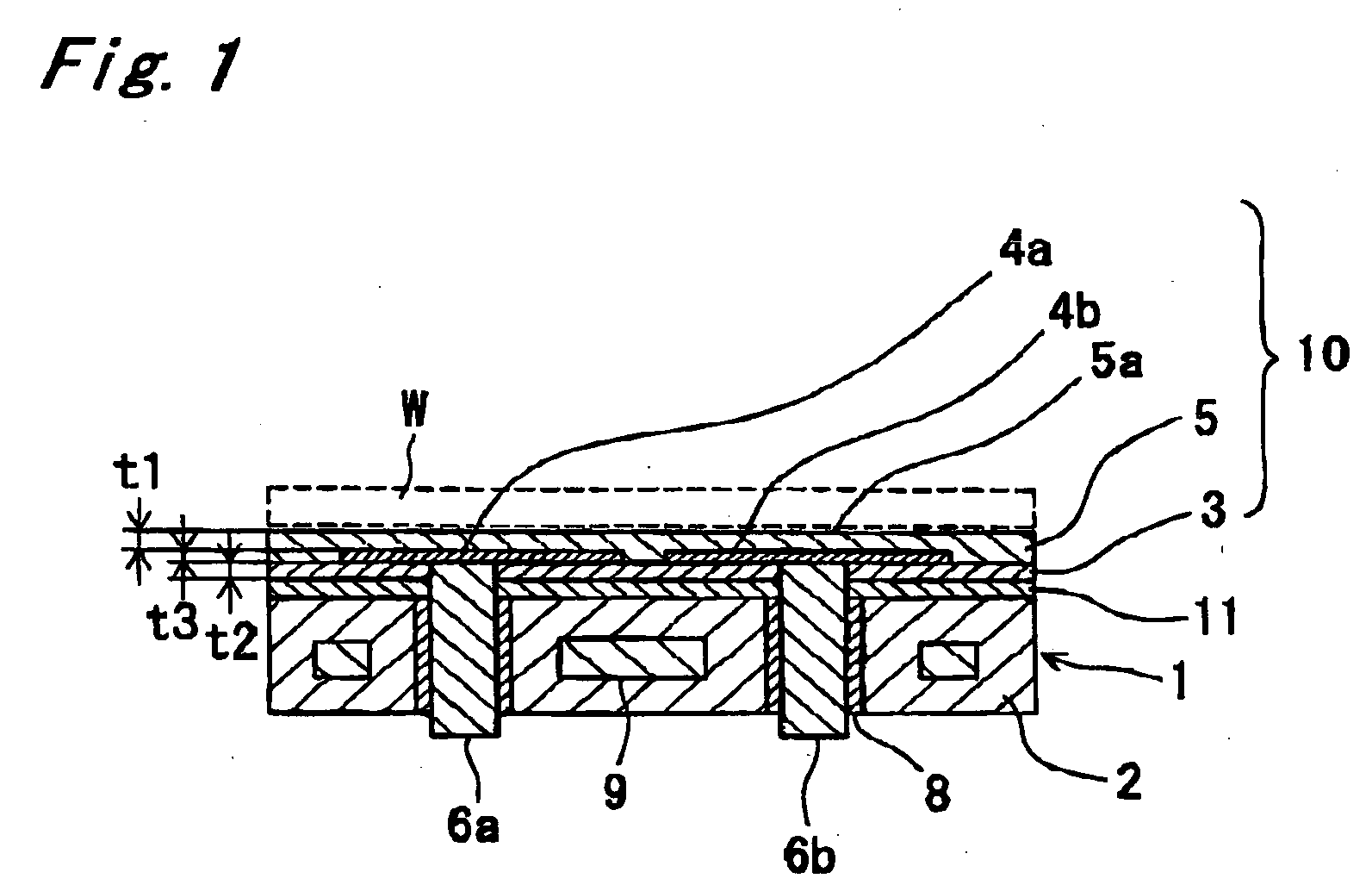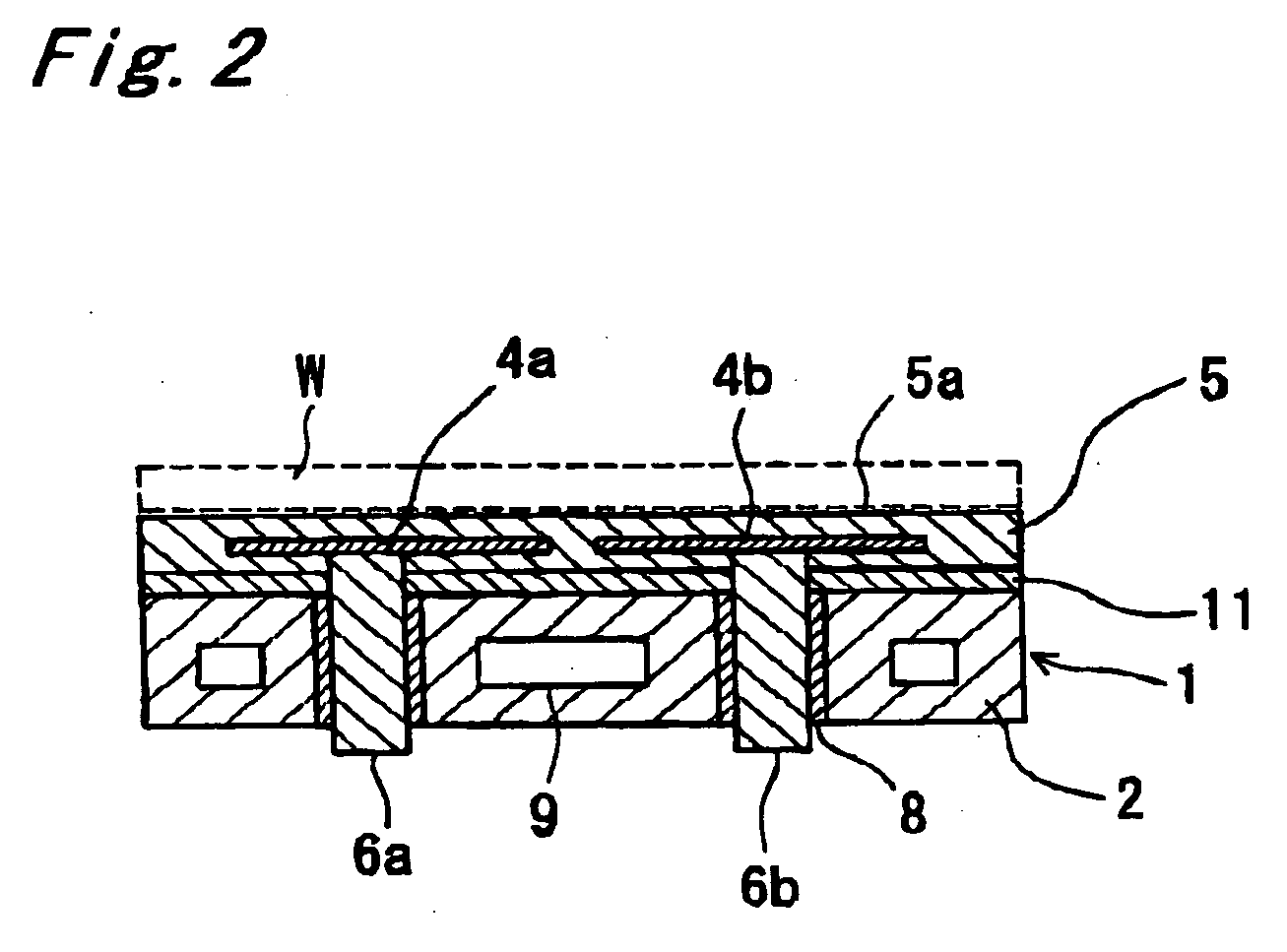Wafer supporting member
a supporting member and wafer technology, applied in the direction of hot plate heating arrangements, transportation and packaging, passenger space, etc., can solve the problems of affecting the wafer, exhibiting a bad cooling efficiency, and conductive base parts having a part of the adsorption force remaining, so as to reduce temperature unbalance, reduce the time to transfer heat, and increase the throughput at the machining process
- Summary
- Abstract
- Description
- Claims
- Application Information
AI Technical Summary
Benefits of technology
Problems solved by technology
Method used
Image
Examples
first embodiment
[0051] Hereinafter, a first embodiment (an electrostatic chuck) of the present invention will be described in details below.
[0052] In the first embodiment of the present invention, the wafer supporting member includes an supporting part including a main surface as a mounting surface for mounting a wafer and the other main surface having an insulating layer provided with a built-in adsorption electrode and having an insulating sheet; the insulating resin layer optionally having a heater attached to the main surface having the adsorption election built therein; and a conductive base part with a passage through which cooling medium flows in, and the resin layer of the wafer supporting member has a volume resistivity in a range of 108 to 1014 Ω·cm. Also, the resistance value between the mounting surface and the conductive base part is preferably in a range of 107 to 1013 Ω. Both of the insulating sheet and the insulating layer are formed of the same planar ceramic body, in which the ab...
example 1
[0129] To the alumina powders, 0.5% by mass of calcium oxide and magnesium oxide in terms of weight were added, which was then mixed using a ball-mill for 48 hours. The obtained alumina slurry passed through a sieve of 325 meshes to remove the impurities attached on the ball or the ball-mill wall, and then dried in a dryer at 120° C. for 24 hours. To the obtained alumina powders, an acrylic binder and a solvent were added and mixed to prepare an alumina slurry. Using this alumina slurry, a green tape was prepared by a doctor blade method.
[0130] Further, several sheets of the green tape were laminated to form a laminate and, on one main surface thereof, an adsorption electrode made of a tungsten carbide paste was printed. On the other hand, several sheets of the separate ceramic green sheets were laminated to form a laminate, which was compressed under pressure to obtain a compressed laminate.
[0131] In addition, the laminate was baked in a baking furnace comprising a W heater and a...
example 2
[0148] In the similar way to that of Example 1, a wafer supporting member made of alumina and aluminum nitride was prepared. The aluminum nitride used had various volume resistivities of the materials by varying the amount of the added cerium oxide within a range or 1 to 15% by mass. The samples were prepared, having different volume resistivities by varying the content of Al in the resin layer. In the same manners as in Example 1, the samples were evaluated. Then, the electric resistance value between the mounting surface and the conductive base part was determined for each of the samples.
[0149] For the electric resistance value between the mounting surface and the conductive base part, an electrode with a diameter of 10 mm was installed on the mounting surface, and the electric resistance value between the electrode and the conductive base part. The measured electric resistance value was taken as a resistance value between the mounting surface and the conductive substrate as calc...
PUM
 Login to View More
Login to View More Abstract
Description
Claims
Application Information
 Login to View More
Login to View More - R&D
- Intellectual Property
- Life Sciences
- Materials
- Tech Scout
- Unparalleled Data Quality
- Higher Quality Content
- 60% Fewer Hallucinations
Browse by: Latest US Patents, China's latest patents, Technical Efficacy Thesaurus, Application Domain, Technology Topic, Popular Technical Reports.
© 2025 PatSnap. All rights reserved.Legal|Privacy policy|Modern Slavery Act Transparency Statement|Sitemap|About US| Contact US: help@patsnap.com



